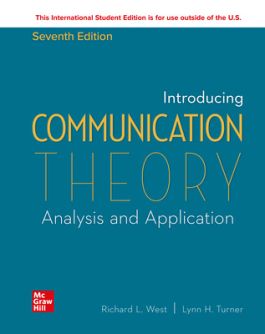ISE Introducing Communication Theory: Analysis and Application
7th Edition
1260575535
·
9781260575538
© 2021 | Published: May 7, 2020
Introducing Communication Theory: Analysis and Application focuses on the links between theory and everyday experiences. This text uses an engaging writing style and a consistent, organized template to present the concept of theory and help students …
Read More
Introducing Communication Theory: Analysis and Application, 7e
Part 1 Foundations
CHAPTER 1: Thinking About Communication: Definition, Models, and Ethics
CHAPTER 2: Thinking About the Field: Traditions and Contexts
CHAPTER 3: Thinking About Theory, Research, and Paradigms
Part 2 Empirical/Post-Positivist Theories
The Self and Messages
CHAPTER 4: Expectancy Violations Theory
Relationship Development
CHAPTER 5: Uncertainty Reduction Theory
CHAPTER 6: Social Exchange Theory
CHAPTER 7: Social Penetration Theory
CHAPTER 8: Social Information Processing Theory
Groups, Teams, and Organizations
CHAPTER 9: Structuration Theory
CHAPTER 10: Organizational Information Theory
The Media
CHAPTER 11: Agenda Setting Theory
CHAPTER 12: Spiral of Silence Theory
CHAPTER 13: Uses and Gratifications Theory
Culture and Diversity
CHAPTER 14: Face-Negotiation Theory
Part 3 Interpretive Theories
The Self and Messages
CHAPTER 15: Symbolic Interaction Theory
CHAPTER 16: Coordinated Management of Meaning
Relationship Development
CHAPTER 17: Communication Privacy Management Theory
Groups, Teams, and Organizations
CHAPTER 18: Groupthink
CHAPTER 19: Organizational Culture Theory
The Public
CHAPTER 20: The Rhetoric
CHAPTER 21: Dramatism
CHAPTER 22: The Narrative Paradigm
The Media
CHAPTER 23: Media Ecology Theory
Culture and Diversity
CHAPTER 24: Communication Accommodation Theory
Part 4 Critical Theories
Relationship Development
CHAPTER 25: Relational Dialectics Theory
The Media
CHAPTER 26: Cultivation Theory
CHAPTER 27: Cultural Studies Theory
Culture and Diversity
CHAPTER 28: Muted Group Theory
CHAPTER 29: Feminist Standpoint Theory
CHAPTER 30: Co-Cultural Theory
Part 1 Foundations
CHAPTER 1: Thinking About Communication: Definition, Models, and Ethics
CHAPTER 2: Thinking About the Field: Traditions and Contexts
CHAPTER 3: Thinking About Theory, Research, and Paradigms
Part 2 Empirical/Post-Positivist Theories
The Self and Messages
CHAPTER 4: Expectancy Violations Theory
Relationship Development
CHAPTER 5: Uncertainty Reduction Theory
CHAPTER 6: Social Exchange Theory
CHAPTER 7: Social Penetration Theory
CHAPTER 8: Social Information Processing Theory
Groups, Teams, and Organizations
CHAPTER 9: Structuration Theory
CHAPTER 10: Organizational Information Theory
The Media
CHAPTER 11: Agenda Setting Theory
CHAPTER 12: Spiral of Silence Theory
CHAPTER 13: Uses and Gratifications Theory
Culture and Diversity
CHAPTER 14: Face-Negotiation Theory
Part 3 Interpretive Theories
The Self and Messages
CHAPTER 15: Symbolic Interaction Theory
CHAPTER 16: Coordinated Management of Meaning
Relationship Development
CHAPTER 17: Communication Privacy Management Theory
Groups, Teams, and Organizations
CHAPTER 18: Groupthink
CHAPTER 19: Organizational Culture Theory
The Public
CHAPTER 20: The Rhetoric
CHAPTER 21: Dramatism
CHAPTER 22: The Narrative Paradigm
The Media
CHAPTER 23: Media Ecology Theory
Culture and Diversity
CHAPTER 24: Communication Accommodation Theory
Part 4 Critical Theories
Relationship Development
CHAPTER 25: Relational Dialectics Theory
The Media
CHAPTER 26: Cultivation Theory
CHAPTER 27: Cultural Studies Theory
Culture and Diversity
CHAPTER 28: Muted Group Theory
CHAPTER 29: Feminist Standpoint Theory
CHAPTER 30: Co-Cultural Theory
Introducing Communication Theory: Analysis and Application focuses on the links between theory and everyday experiences. This text uses an engaging writing style and a consistent, organized template to present the concept of theory and help students become insightful, critical thinkers. The Connect course for this offering includes SmartBook, an adaptive reading and study experience that guides students to master, recall, and apply key concepts while providing automatically graded assessments.

